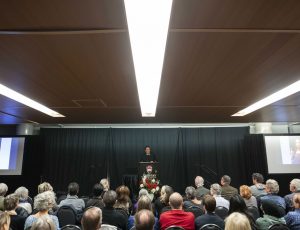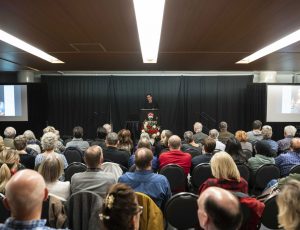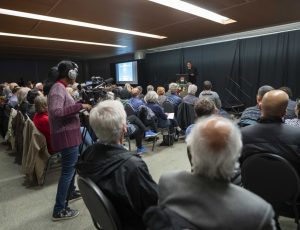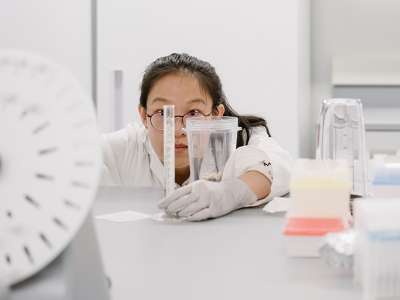By Tyrone Burke
Photos by Chris Roussakis
Leonardo da Vinci was prolific in producing sketches and notes, but as a painter, he was painfully slow. It took him four years to paint the Mona Lisa and, in all, fewer than 20 paintings that are attributed to the Renaissance master.
Salvator Mundi is one of them. Latin for “saviour of the world,” it’s a portrait of Jesus of Nazareth wearing Renaissance robes, as he gazes magnanimously and cradles a crystal orb. It’s one of Leonardo’s most copied paintings, but for centuries the original was thought to be lost. Then it was found, and now it’s missing again.
Less than 20 years ago, Salvator Mundi was hanging inconspicuously in a stairwell in Louisiana. Overpainting had obscured the 500-year-old work. The passage of time had worn the paint and warped the walnut panel that backed it.
It went to auction as part of an estate sale in 2005 and sold for $1,000 to a New York City art dealer who thought it might be an early copy of Leonardo’s work. During restoration, signs pointed to the painting being the original. In 2017 Christie’s sold it at auction for more than $450 million – the highest price ever paid for a work of art.
Salvator Mundi: An Interational Mystery
Then, it disappeared again. Its buyer was a Saudi prince and the plan was for the painting to be displayed at the Louvre Abu Dhabi beginning in 2018. That never happened and rumours swirled that the missing masterpiece was on board the yacht of Saudi crown prince Mohammed bin Salman – though there was no actual evidence to support the claim.
So how exactly did Salvator Mundi go from the home of a Baton Rouge businessman to the centre of an international mystery involving a monarch’s super yacht?
“During restoration, remarkable things emerged,” says Martin Kemp, emeritus professor in the history of art at the University of Oxford and a leading scholar of Leonardo’s art.
On Nov. 21, 2019, Kemp delivered Leonardo’s Salvator Mundi: The Story and the Research at this year’s Herzberg Lecture at Richcraft Hall. The annual lecture honours Gerhard Herzberg, a former chancellor of Carleton University and recipient of the 1971 Nobel Prize for Chemistry.
“Perhaps the most telling are pentimento — the Italian word for regret, or a change of mind. When the cleaning was done, there was a trace of an earlier position of the thumb — a kind of ghost thumb that’s straight. All of the copies of the painting all have a tucked-in thumb, and not a straight thumb. That doesn’t prove it is Leonardo’s work, but it does mean that important creative work is going on in order to determine the correct position of the hand.”
It wasn’t the only pentimento in the painting, and there were other signs too. The locks of Jesus cascaded helically, as in Leonardo’s sketches of turbulence.
“Leonardo was deeply involved in what I call the science of art,” says Kemp.
“How things behave . . . how materials behave and how light behaves. The curls of his hair have been painted with enormous vitality — living vortices painted with brilliant touch. Leonardo compared this kind of curling with the movement of water.”
Painting Techniques Point to Leonardo
Before it was sold at auction, Kemp had the opportunity view and study the work, and he notes that it uses painting techniques that were favoured by Leonardo.
“Above the eye brow, there is the print from the edge of a hand. You would press this bit of the hand against the moist paint to achieve a soft modeling effects. It’s not a fingerprint — this is not a crime scene investigation — but that pattern of the hand, pressed gently into the paint to create a blending of the highlights and the flesh tones . . . it’s very characteristic of Leonardo, but on the whole, his pupils did not do it.”
For the time being, analysis of the work by art historians will necessarily be limited to memory and photography. Salvator Mundi’s location remains unknown, and it was not included in a major showing of Leonardo’s work that opened at the Louvre in Paris in October 2019.
“This is a picture that should be in the public domain,” Kemp says, “but I’m not worried it won’t be looked after. If you pay $450 million, you’re probably going to get good advice and look after it carefully.”
The Herzberg lecture this year was part of Cinquecento – Carleton’s year-long celebration that has been looking at da Vinci’s work with fresh eyes. In Italian, Cinquecento means 500 and, for this series of events, refers to the 500 years since his passing.
Tuesday, November 26, 2019 in Faculty of Science
Share: Twitter, Facebook









